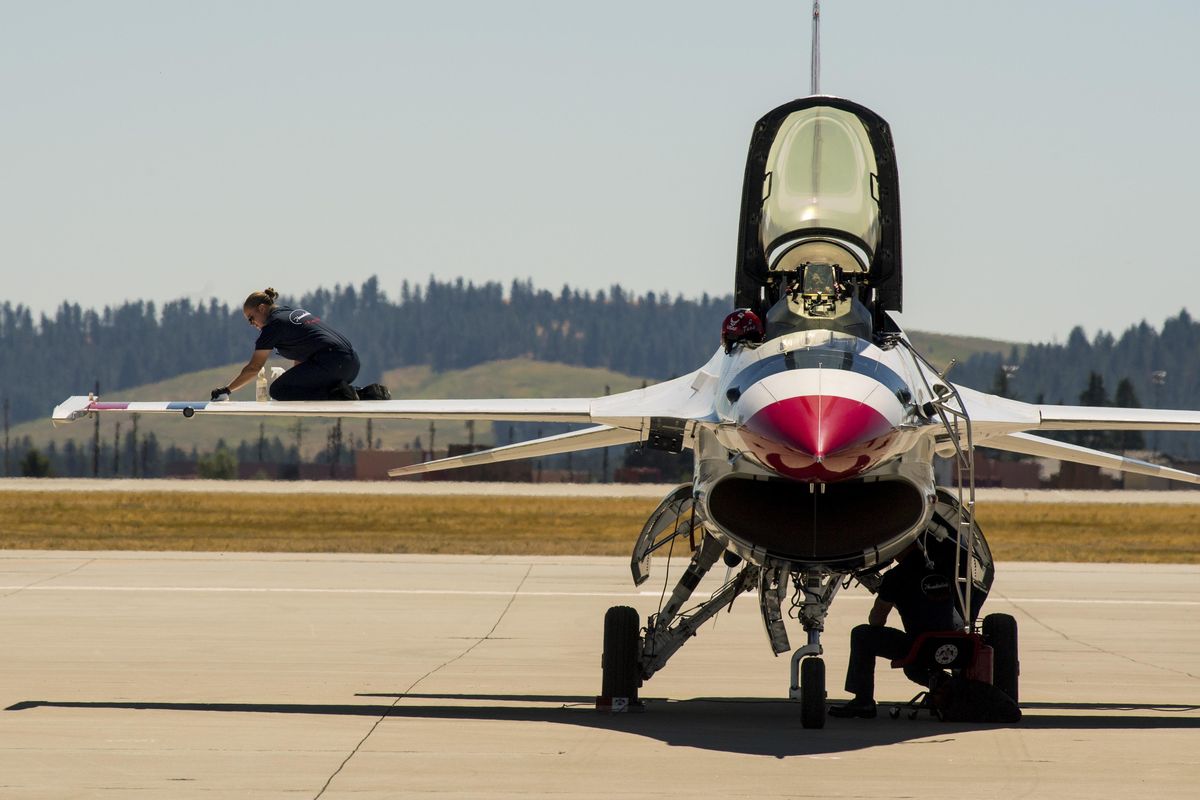Behind the mavericks: How one Thunderbirds crewman keeps the geese afloat for SkyFest weekend

While the mavericks are up above, twisting and turning to the delight of the crowd below, Chief Inspector Ryan Smith is perfectly content on the ground, where he belongs.
As the man in charge of making sure each Thunderbird can properly flap its wings, it’s where he spends the majority of his time. Without him, the hundreds of thousands in attendance at SkyFest over the weekend at Fairchild Air Force Base wouldn’t have the Air Force’s premier demonstration squadron to look forward to.
“Think of your laptop at home,” the master sergeant said Sunday. “If you were to bang it around every day going around 6 Gs, you’d need to fix it up pretty often.”
Smith and his fellow ground crew constitute the majority of the 120-person force that travels across the United States, putting on white-knuckle aerial maneuvers for thousands of screaming fans. On Sunday at Fairchild, he walked along each of the six planes lined up on the tarmac hours before they were to suck the sound of the sky, ensuring each one was fit to fly.
“I work on all of the components of the F-16,” he said. “Radios, navigation – essentially the brains of the plane.”
It’s an important job, but not one most people think about when an arrowhead loop goes off without a hitch, or when a calypso pass is accomplished to perfection. There are no movies dedicated to Smith’s job starring Tom Cruise.
There’s only the tragedy that transpires if the machine carrying 7,000 pounds of jet fuel malfunctions. Like in June 2016, when a throttle malfunction forced Thunderbirds pilot Maj. Alex Turner to eject during an air show over President Barack Obama and Air Force Academy cadets at a graduation ceremony near Colorado Springs.
Smith, who’s 18 months into his three years on the Thunderbirds team, said situations like that don’t happen often, especially considering the dozens of cities they visit every year, sometimes putting on multiple shows a day. But when they do, it’s a sobering experience for the team, he said, and something he and the team immediately work to correct.
“There’s just something about being able to see the reaction from the crowd when these planes get going and knowing it’s because of your hard work,” he said. “It’s important.”
And it isn’t easy, Smith said. A jet engine operates on the same basic principle as a traditional combustion engine: Use a fuel source to get something moving. Only a jet engine, such as the ones in Thunderbirds’ F-16 Fighting Falcons, creates a lot more force than what can be found under the hood of a minivan and uses a great deal more fuel to do so.
“It’s the same basic concept, just a much larger scale,” he said. “It’s extremely powerful.”
Originally from Cleveland, Smith joined the Air Force because he wasn’t a huge fan of school, he said, and because “it just looked interesting” to him. He knew the route of a pilot wasn’t for him, so he relegated himself to the background, making sure the pilots had something worthy to fly.
Before long, he applied for the Thunderbirds, excited by the prospect of traveling most of the year and encountering new faces. Since being in Airway Heights, he said he’s been approached by multiple people while out to dinner in uniform, thanking him for his service and admiring the “Thunderbirds” patch emblazoned on his jumpsuit.
“It’s the reaction from the crowd that gives me goosebumps each time,” he said. “When we do a show, and the crowd is into it, there’s nothing better.”